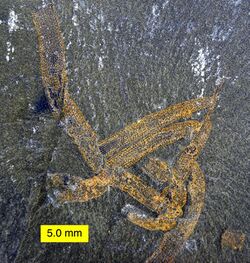Biology:Vauxia
From HandWiki
Short description: Extinct genus of sponges
| Vauxia | |
|---|---|

| |
| Vauxia from the Walcott Quarry of the Burgess Shale (Middle Cambrian) | |
| Scientific classification | |
| Domain: | Eukaryota |
| Kingdom: | Animalia |
| Phylum: | Porifera |
| Class: | Demospongiae |
| Order: | Verongiida |
| Family: | †Vauxiidae |
| Genus: | †Vauxia Walcott, 1920 |
| Species | |
| |
Vauxia is an extinct genus of demosponge that had a distinctive branching mode of growth. Each branch consisted of a network of strands. Vauxia also had a skeleton of spongin (flexible organic material) common to modern day sponges. Much like Choia and other sponges, Vauxia fed by extracting nutrients from the water.
Vauxia is named after Mount Vaux, a mountain in Yoho National Park, British Columbia. It was first described in 1920 by Charles Doolittle Walcott.[2]
Vauxia fossils are found in North America, specifically in the United States and Canada .[3]
References
- ↑ Botting, J. (2007). "'Cambrian' demosponges in the Ordovician of Morocco: Insights into the early evolutionary history of sponges". Geobios 40 (6): 737–748. doi:10.1016/j.geobios.2007.02.006.
- ↑ Walcott, C. D. (1920). "Cambrian geology and paleontology IV:6—Middle Cambrian Spongiae". Smithsonian Miscellaneous Collections 67: 261–364. https://biodiversitylibrary.org/page/29838882.
- ↑ Paleobiology Database
External links
- "Vauxia gracilenta". Burgess Shale Fossil Gallery. Virtual Museum of Canada. 2011. http://burgess-shale.rom.on.ca/en/fossil-gallery/view-species.php?id=126.
- Fauna and Flora of the Burgess Shale
Wikidata ☰ Q7917470 entry
 |

